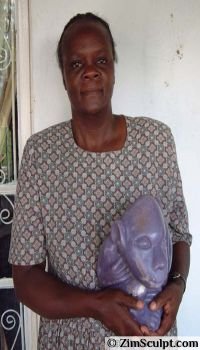Maud met Joram Mariga in 1976 and it was then that he first taught her to sculpt. They married in 1983 and for the first four years after her marriage she helped Joram with the finishing of his own work. Meanwhile, rather than helping her directly with her own work, Joram preferred instead to encourage Mauds individual creativity and efforts. In particular he urged her to use the hardest stone such as Leopard Rock or Springstone, rather than the softer Soapstone, a material with which many other sculptors begin. It is hard for women to have the confidence to start because the stones are very hard. In the first days it took me a long time because I was learning how to do it. She also found it difficult makin gtime in which to sculpt, with only two or three hours in the afternoon free from domestic and family chores.
In 1989 Joram and Maud moved from Nyanga to Harare and after encouragement from fellow sculptor Mary Ndandarika, Maud presented two sculptures to Chapungu Sculpture Park and three to the National Gallery of Zimbabwe. She now sculpts full time.
The majority of her sculpture, she says, have stories attached to them, often provoked by the stone itself. “I don’t know what is going to come out of that stone, but I start to carve it. My husband taught me that when I get a piece of stone I must look at that piece of stone first”. She discusses her work freely and explains the inspiration for specific pieces.
For Maud, the story she attaches to each sculpture completes their identity: Identities which remain her own and are characterised by areas of untouched, natural stone which cause textural strength and excitement to works that are largely polished. An aspect whihc unites her with many other femal sculptors is that she often finds the subject of women an inspirational starting point for her work. Despite being taught, and subsequently encouraged, by her husband, Maud confidently defends the ongoing developement of her own artistic character.



